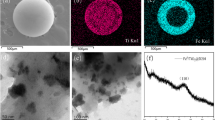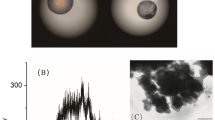Abstract
Tl(I) in water even at a trace level is fatal to human beings and the ecosystem. Here we fabricated a new polymer-supported nanocomposite (HMO-001) for efficient Tl(I) removal by encapsulating nanosized hydrous manganese dioxide (HMO) within a polystyrene cation exchanger (D-001). The resultant HMO-001 exhibited more preferable removal of Tl(I) than D-001 and IRC-748, an iminodiacetic chelating polymer, particularly in the presence of competing Ca(II) ions at greater levels in solution. Such preference was ascribed to the Donnan membrane effect caused by D-001 as well as the specific interaction between Tl(I) and HMO. The adsorbed Tl(I) was partially oxidized into insoluble Tl(III) by HMO at acidic pH, while negligible oxidation was observed at circumneutral pH. The exhausted HMO-001 was amenable to efficient regeneration by binary NaOH-NaClO solution for at least 10-cycle batch runs without any significant capacity loss. Fixed-bed column test of Tl(I)-contained industrial effluent and natural water further validated that Tl(I) retention on HMO-001 resulted in a conspicuous concentration drop from 1.3 mg/L to a value lower than 0.14 mg/L (maximum concentration level for industrial effluent regulated by US EPA) and from 1–4 μg/L to a value lower than 0.1 μg/L (drinking water standard regulated by China Health Ministry), respectively.
Similar content being viewed by others
References
Delvalls TA, Saenz V, Arias AM, Blasco J. Thallium in the marine environment: First ecotoxicological assessments in the Guadalquivir estuary and its potential adverse effect on the Donana European natural reserve after the Aznalcollar mining spill. Ciencias Marinas, 1999 25: 161–175
Kazantzis G. Thallium in the environment and health effects. Environ Geochem Health, 2000, 22: 275–280
Peter ALJ, Viraraghavan T. Thallium: A review of public health and environmental concerns. Environ Int, 2005, 31: 493–501
Casiot C, Egal M, Bruneel O, Verma N, Parmentier M, Elbaz-Poulichet F. Predominance of aqueous Tl(I) species in the river system downstream from the abandoned Carnoules mine (Southern France). Environ Sci Technol, 2011, 45: 2056–2064
Xiong YL. The aqueous geochemistry of thallium: Speciation and solubility of thallium in low temperature systems. Environ Chem, 2009, 6: 441–451
Zitko V. Toxicity and pollution potential of thallium. Sci Total Environ, 1975, 4: 185–192
Seiler HG, Sigel H, Sigel A. Handbook on Toxicity of Inorganic Compounds. New York: Marcel Dekker Inc., 1989
Cheam V. Thallium contamination of water in Canada. Water Qual Res J Can, 2001, 36: 851–878
Kazantzis G. Thallium Handbook on the Toxicology of Metals. Amersterdam: Elsevier Science, 1986. 549–567
Leonard A, Gerber GB. Mutagenicity, carcinogenicity and teratogenicity of thallium compounds. Mutat Res-Rev Mutat, 1997, 387: 47–53
Zhang Z, Zhang BG, Long JP, Zhang XM, Chen GL. Thallium pollution associated with mining of thallium deposits. Sci China, Ser D, 1998, 41: 75–81
US EPA (Environmental Protection Agency). Technical factsheet on: Thallium. http://www.epa.gov/safewater/dwh/t-ioc/thallium.html, 2002
China MH (Ministry of Health). Standard for drinking water quality. GB 5749-2006, 2006
Xiao TF, Boyle D, Guha J, Rouleau A, Hong YT, Zheng BS. Groundwater-related thallium transfer processes and their impacts on the ecosystem: Southwest Guizhou Province, China. Appl Geochem, 2003, 18: 675–691
Zhang L, Huang T, Zhang M, Guo XJ, Yuan Z. Studies on the capability and behavior of adsorption of thallium on nano-Al2O3. J Hazard Mater, 2008, 157: 352–357
Senol ZM, Ulusoy U. Thallium adsorption onto polyacryamide-aluminosilicate composites: A Tl isotope tracer study. Chem Eng J, 2010, 162: 97–162
Yantasee W, Warner C, Sangvanich T, Addleman RS, Carter TM, Wiacek RJ, Fryxell GE, Timchalk C, Warner MG. Removal of heavy metals from aqueous systems with thiol functionalized superparamagnetic nanoparticles. Environ Sci Technol, 2007, 41: 5114–5119
Sangvanich T, Sukwarotwat V, Wiacek RJ, Grudzien RM, Fryxell GE, Addleman RS, Timchalk C, Yantasee W. Selective capture of cesium and thallium from natural waters and simulated wastes with copper ferrocyanide functionalized mesoporous silica. J Hazard Mater, 2010, 182: 225–231
Cumbal L, SenGupta AK. Arsenic removal using polymer-supported hydrated iron(III) oxide nanoparticles: Role of Donnan membrane effect. Environ Sci Technol, 2005, 39: 6508–6515
Pan BJ, Wu J, Pan BC, Lv L, Zhang WM, Xiao LL, Wang XS, Tao XS, Zheng SR. Development of polymer-based nanosized hydrated ferric oxides (HFOs) for enhanced phosphate removal from waste effluents. Water Res, 2009, 43: 4421–4429
Sarkar S, SenGupta AK. The Donnan membrane principle: Opportunities for sustainable engineered processes and materials. Environ Sci Technol, 2010, 44: 1161–1166
Zhao X, Lv L, Pan BC, Zhang WM. Polymer-supported nanocomposites for environmental application: A review. Chem Eng J, 2011, 170: 381–394
Zhang QR, Pan BC, Zhang WM, Pan BJ, Jia K, Zhang QX. Selective sorption of lead, cadmium, and zinc ions by a polymeric cation exchanger containing nano-Zr(HPO3S)2. Environ Sci Technol, 2008, 42: 4140–4145
Parida KM, Kanungo SB, Sant BR. Studies on MnO2. 1. Chemical composition, microstructure and other characteristics of some synthetic MnO2 of various crystalline modifications. Electrochimica Acta, 1981, 26: 435–443
Pan BC, Su Q, Zhang WM, Zhang QX, Ren HQ, Zhang QR. A process to prepare a hybrid sorbent by impregnating hydrous manganese dioxide (HMO) nanoparticles within polymer for enhanced removal of heavy metals. Chinese Patent, 200710134050.9, 2007
Lowry GV, Johnson KM. Congener-specific dechlorination of dissolved PCBs by microscale and nanoscale zerovalent iron in a water/methanol solution. Environ Sci Technol, 2004, 38: 5208–5216
Yavuz CT, Mayo JT, Yu WW, Prakash A, Falkner JC, Yean S, Cong L, Shipley HJ, Kan A, Tomson M, Natelson D, Colvin VL. Low-field magnetic separation of monodisperse Fe3O4 nanoparticles. Science, 2006, 314: 964–967
Lafferty BJ, Ginder-Vogel M, Zhu MQ, Livi KJT, Sparks DL. Arsenite oxidation by a poorly crystalline manganese-oxide. 2. Results from X-ray absorption spectroscopy and X-ray diffraction. Environ Sci Technol, 2010, 44: 8467–8472
Misono M, Ochiai E, Saito Y, Yoneda Y. A new dual parameter scale for the strength of Lewis acids and bases with the evaluation of their softness. J Inorg Nucl Chem, 1967, 29: 2685–2691
Dahal MP, Lawrance GA. Adsorption of thallium(I), lead(II), copper( II), bismuth(III) and chromium(III) by electrolytic manganese dioxide. Adsorp Sci Technol, 1996, 13: 231–240
Xu Y, Boonfueng T, Axe L, Maeng S, Tyson T. Surface complexation of Pb(II) on amorphous iron oxide and manganese oxide: Spectroscopic and time studies. J Colloid Interface Sci, 2006, 299: 28–40
Bidoglio G, Gibson PN, Ogorman M, Roberts KJ. X-ray absorption spectroscopy investigation of surface redox transformations of thallium and chromium on colloidal mineral oxides. Geochim Cosmochim Acta, 1993, 57: 2389–2394
Lin KD, Liu WP, Gan J. Oxidative removal of bisphenol A by manganese dioxide: Efficacy, products, and pathways. Environ Sci Technol, 2009, 43: 3860–3864
Stumm W, Morgan JJ. Aquatic Chemistry. 3rd Ed. New York: Wiley, 1996
Dogan M, Abak H, Alkan M. Adsorption of methylene blue onto hazelnut shell: Kinetics mechanism and activation parameters. J Hazard Mater, 2009, 164: 172–181
Pan BC, Zhang QR, Zhang WM, Pan BJ, Du W, Lv L, Zhang QJ, Xu ZW, Zhang QX. Highly effective removal of heavy metals by polymer-based zirconium phosphate. A case study of lead ion. J Colloid Interface Sci, 2007, 310: 99–105
Pan BC, Zhang QX, Meng FW, Li XT, Zhang X, Zheng JZ, Zhang WM, Pan BJ, Chen JL. Sorption enhancement of aromatic sulfonates onto an aminated hyper-cross-linked polymer. Environ Sci Technol, 2005, 39: 3308–3313
Author information
Authors and Affiliations
Corresponding author
Electronic supplementary material
Rights and permissions
About this article
Cite this article
Pan, B., Wan, S., Zhang, S. et al. Recyclable polymer-based nano-hydrous manganese dioxide for highly efficient Tl(I) removal from water. Sci. China Chem. 57, 763–771 (2014). https://doi.org/10.1007/s11426-013-4992-8
Received:
Accepted:
Published:
Issue Date:
DOI: https://doi.org/10.1007/s11426-013-4992-8




